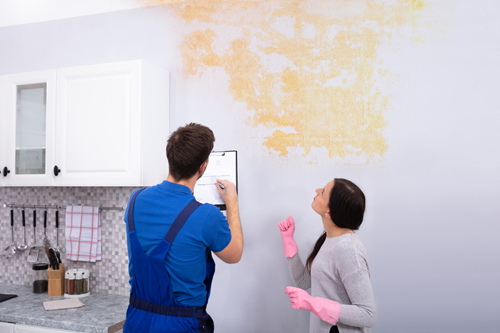Do's and Don'ts Throughout Water Damages Emergencies.
Do's and Don'ts Throughout Water Damages Emergencies.
Blog Article
Were you looking for insight concerning Ways to Reduce The Risk Of Fire And Water Damage?

Water provides life, yet water invasion on some parts where it's not expected to be can result in damage and also aggravation. It can peel away the surface area as well as erode the product's foundation if the water seeps right into your structure. Mold and mildew and mold also grow in a damp setting, which can be hazardous for your and also your household's wellness. Additionally, residences with water damage odor old and also moldy.
Water can come from lots of resources like typhoons, floods, burst pipes, leaks, and sewer issues. It's much better to have a functioning expertise of security precautions if you have water damages. Right here are a few guidelines on just how to take care of water damage.
Do Prioritize Residence Insurance Coverage Protection
Seasonal water damage can come from floods, seasonal rainfalls, and also wind. There is additionally an incident of an unexpected flood, whether it originated from a faulty pipeline that unexpectedly breaks right into your home. To shield your home, obtain home insurance policy that covers both acts of God such as natural catastrophes, and emergency situations like damaged plumbing.
Don't Neglect to Turn Off Energies
When disaster strikes and also you're in a flood-prone area, turn off the major electrical circuit. Shutting off the power stops
When water comes in as water offers as a conductor, electrical shocks. Don't neglect to turn off the major water line valve as a method to stop even more damages.
If the floodwaters are obtaining high, keep your furniture steady as they can move around as well as cause extra damages.
Do Stay Proactive as well as Heed Weather Condition Informs
If you live in a location plagued by floods, stay proactive and also ready at all times. Listen to the news and also discharge warnings if you live near a body of water like a creek, lake, or river .
Do Not Neglect the Roofing System
Your contractor ought to take care of the malfunctioning gutters or any type of various other signs of damage or weakening. An examination will avoid water from moving down your wall surfaces and saturating your ceiling.
Do Pay Attention to Small Leaks
A ruptured pipeline does not take place in a vacuum cleaner or over night. There are red flags that can draw your attention as well as show to you some damaged pipelines in your house. Indications of red flags in your pipes include bubbling paint, peeling wallpaper, water streaks, water spots, or trickling sounds behind the walls. There are indicators that the pipe will rupture. If you see these indications, do not wait on an escalation. Repair service and evaluate your plumbing repaired before it leads to huge damages to your house, funds, and an individual problem.
Don't Panic in Case of a Burst Pipeline
Timing is crucial when it comes to water damages. If a pipeline ruptureds in your residence, right away shut off your primary water valve to cut off the source and avoid more damage. Call a reliable water damage restoration specialist for aid.
Water offers life, yet water breach on some components where it's not meant to be can result in damage and aggravation. In enhancement, homes with water damages smell mildewy as well as old.
Seasonal water damage can come from floods, seasonal rains, and wind. Signs of red flags in your pipelines consist of gurgling paint, peeling wallpaper, water streaks, water stains, or trickling audios behind the walls. If a pipeline bursts in your home, instantly closed off your primary water valve to reduce off the source and protect against even more damage.
Some Do's & Don't When Dealing with a Water Damage
DO:
Make sure the water source has been eliminated. Contact a plumber if needed. Turn off circuit breakers supplying electricity to wet areas and unplug any electronics that are on wet carpet or surfaces Remove small furniture items Remove as much excess water as possible by mopping or blotting; Use WHITE towels to blot wet carpeting Wipe water from wooden furniture after removing anything on it Remove and prop up wet upholstery cushions for even drying (check for any bleeding) Pin up curtains or furniture skirts if needed Place aluminum foil, saucers or wood blocks between furniture legs and wet carpet Turn on air conditioning for maximum drying in winter and open windows in the summer Open any drawers and cabinets affected for complete drying but do not force them open Remove any valuable art objects or paintings to a safe, dry place Open any suitcases or luggage that may have been affected to dry, preferably in sunlight Hang any fur or leather goods to dry at room temperature Punch small holes in sagging ceilings to relieve trapped water (don't forget to place pans beneath!); however, if the ceiling is sagging extremely low, stay out of the room and we'll take care of it DO NOT:
Leave wet fabrics in place; dry them as soon as possible Leave books, magazines or any other colored items on wet carpets or floor Use your household vacuum to remove water Use TV's or other electronics/appliances while standing on wet carpets or floors; especially not on wet concrete floors Turn on ceiling fixtures if the ceiling is wet Turn your heat up, unless instructed otherwise

I ran across that content on Fire And Water Damage Prevention while doing a search on the internet. Loved our post? Please share it. Help another person check it out. Many thanks for your time. Come back soon.
Report this page